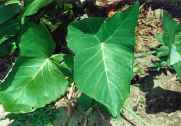Xanthosoma brasilense
Tahitian taro, Tanier spinach, Belembe
Tropical
Introduction
Tanier spinach is one of several important food crops in the arum – lily or Araceae family, which also includes taro (Colocasia esculenta) and tannia (Xanthosoma sagittifolium). Visual similarities among many closely related species, a proliferation of common names, and the fact that most of the production of these foods is done by subsistence growers make this a difficult family to investigate.
The Xanthosoma branch originated in the Amazonian region of South America and was widely cultivated long before Columbus arrived in the New World. The Colocasia branch began in India and was spread throughout tropical Asia and Africa by ancient sailors. Of the edible aroid plants tanier spinach or belembe stands out because it is grown solely for its leaves. Other species, though they have edible leaves, are grown primarily for their starchy corms, or underground stems that are cooked as a staple food.
Pros
- Unlike other members of this family, tanier spinach leaves don't contain raphides. These are needle-like crystals of calcium oxalate that can be extremely irritating in the mouth if not thoroughly cooked.
- Tanier spinach is essentially a swamp plant that is relatively pest free. It thrives in hot wet conditions where many food crops can't survive due to waterlogging, fungus and virus attacks.
- Tanier spinach is a key ingredient in the almost mystically popular West Indian stew called 'Calalu'. Its leaves are considered one of the tastiest of all the world's many potherbs.
- It is rich in vitamins A and C and in phosphorus and contains a significant amount of protein.
- It is grown successfully by subsistence farmers in areas of the world where malnutrition is a real threat.
- This plant grows and produces nutritious greens year round and will continue for up to two years before losing vigor.
Cons
- Though tanier spinach doesn't have the irritating raphides of other members of this family, its calcium is still partially unavailable because of oxalates in another form.
- Won't grow well in sandy soil or soil with very low organic matter content
- Can't tolerate prolonged periods of dry soil
- Relatively high labor requirements, especially for transplanting
- A difficult plant to improve genetically and one not well suited to mechanized production
Notes
- Young leaves are sometimes eaten raw, but are sometimes irritating to the mouth.
- Can be successfully grown in soils with pH 5.0 –8.0.
- Typically grown at a density of about 14,000 - 20,000 plants per hectare.
- Tanier spinach is relatively shade tolerant and is sometimes intercropped with bananas or coconut.
Seeds
- Tanier spinach rarely produces seeds and is normally propagated from corms or stem cuttings that must be obtained locally.
Related Plants with Edible Leaves
Colocasia esculenta (taro or cocoyam); Xanthosoma sagittifolium (tannia or yautia); Amorphophallus campanulatus (elephant yam)
